1993 CHEVROLET LUMINA air condition
[x] Cancel search: air conditionPage 241 of 324
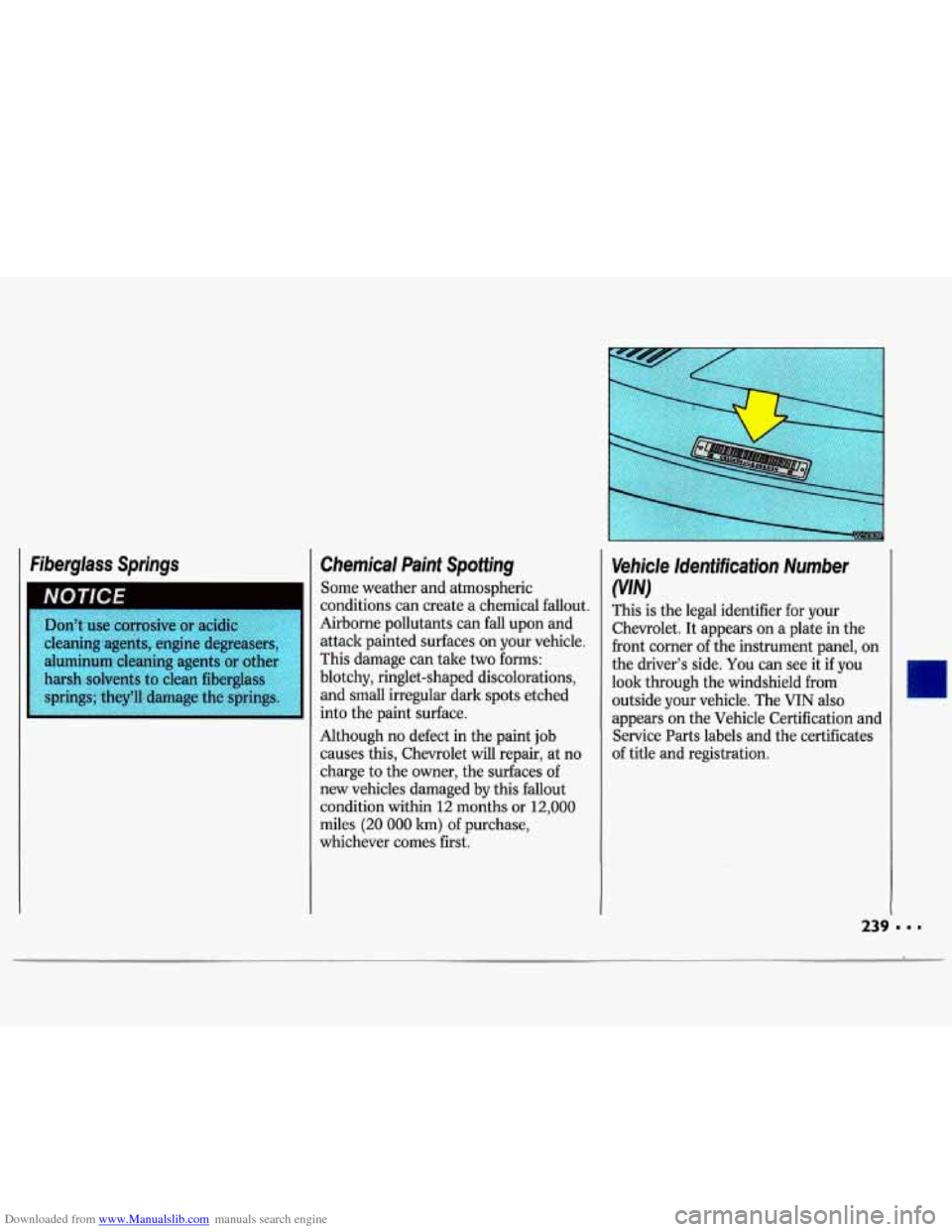
Downloaded from www.Manualslib.com manuals search engine Fiberglass Springs Chemical Paint Spotting
Some weather and atmospheric
conditions can create a chemical fallout.
Airborne pollutants can fall upon and
attack painted surfaces on your vehicle.
This damage can tale two forms:
blotchy, ringlet-shaped discolorations, and small irregular dark spots etched
into the paint surface.
Although no defect in the paint job
causes this, Chevrolet will repair, at no
charge to the owner, the surfaces of
new vehicles damaged by this fallout
condition within 12 months or 12,000
miles (20
000 km) of purchase,
whichever comes first.
Vehicle Identification Number
0
This is the legal identifier for your
Chevrolet. It appears on
a plate in the
front corner of the instrument panel,
on
the driver's side. You can see it if you
look through the windshield from
outside your vehicle. The VIN also
appears on the Vehicle Certification and
Service Parts labels and the certificates
of title and registration.
Page 245 of 324

Downloaded from www.Manualslib.com manuals search engine 30
30
30
20
Component Center
Fuse Rating Circuitry
(AMP.)
1 Defogger Timer Relay
2 Air Conditioner Blower Relay (HI)
3 Air Conditioner Blower Relay (LO)
4 Rear Defogger and WAC Circuit Breaker
5 Power Door Lock Circuit Breaker
6 Power Window Circuit Breaker
7 Headlight Circuit Breaker
8 Not Used
9 Hazard Flasher
10 Chime Module
11 Not Used
Page 250 of 324
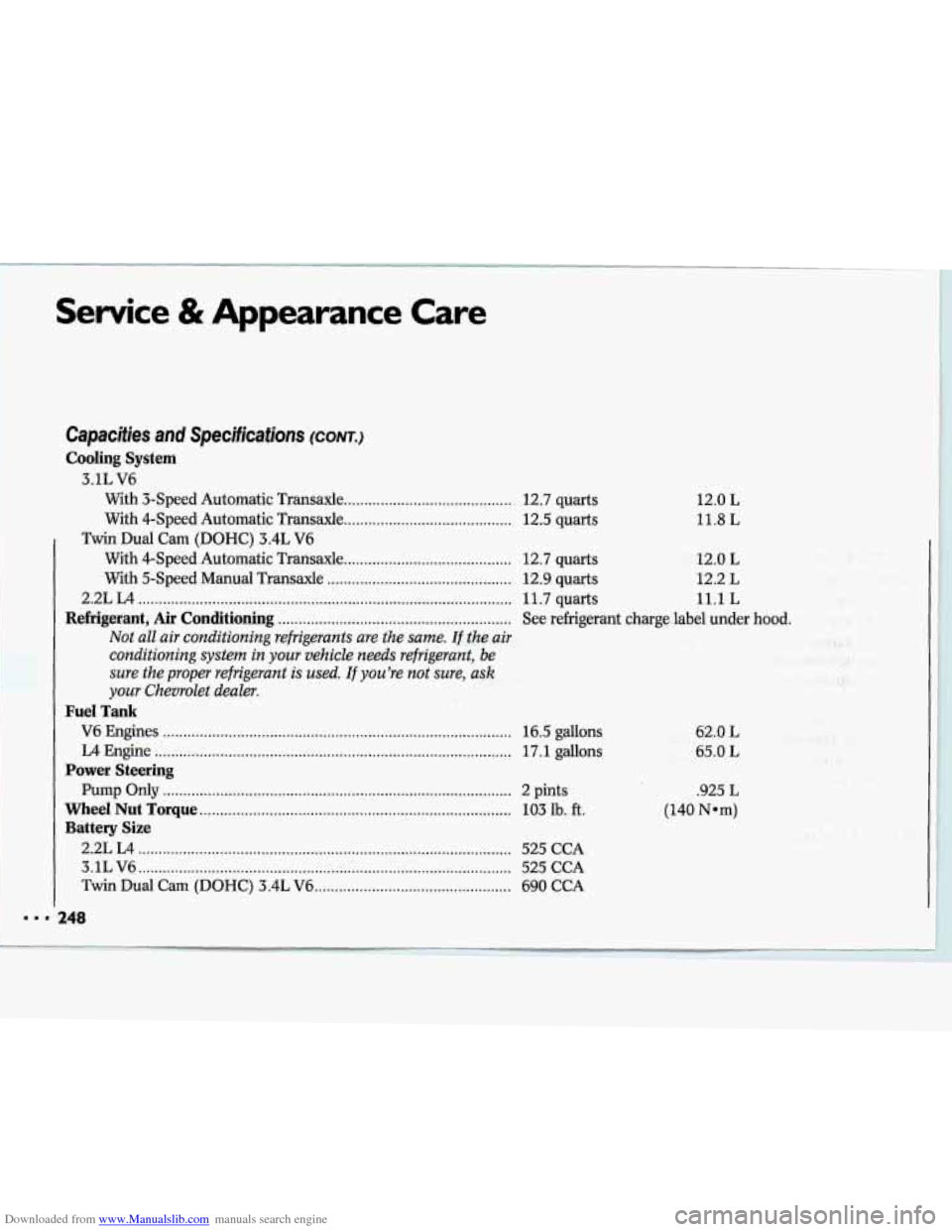
Downloaded from www.Manualslib.com manuals search engine Service & Appearance Care
Capacities and Specifications (CONT.)
Cooling System
3.1L V6 With 3-Speed Automatic Transaxle
......................................... 12.7 quarts
With 4-Speed Automatic Transaxle
......................................... 12.5 quarts
With 4-Speed Automatic Transaxle
......................................... 12.7 quarts 12.0 L
With 5-Speed Manual Transaxle 12.9 quarts 12.2 L
Twin Dual
Cam (DOHC) 3.4L
V6
-%<&? I> -- .............................................
2.2L L4 ........................................................................\
................... 11.7 quarts 11.1 L :,gRB",i A
Not all air conditioning refrigerants are the same. If the air &p&!#j ... 2
conditioning system in your vehicle needs refrigerant, be &3%Si hkL
sure the proper refrigerant is used. If you're not sure, ask .=@, , 'i
your Chevrolet dealer.
,-
Refrigerant, Air Conditioning ......................................................... See refrigerant charge label under hood. ;I ~s~t:
Fuel Tank
........................................................................\
.............
........................................................................\
............... V6 Engines 16.5 gallons
L4 Engine 17.1 gallons
Power Steering
Wheel Nut Torque
........................................................................\
.... 103 lb. ft.
Battery Size
, Pump Only ........................................................................\
............. 2 pints
2.2L L4
........................................................................\
................... 525 CCA
3.1L V6
........................................................................\
................... 525 CCA
Twin Dual Cam (DOHC) 3.4L V6
................................................ 690 CCA
... 248
12.0 L
11.8 L
62.0 L 65.0 L
.925 L
(140 Nom)
Page 262 of 324
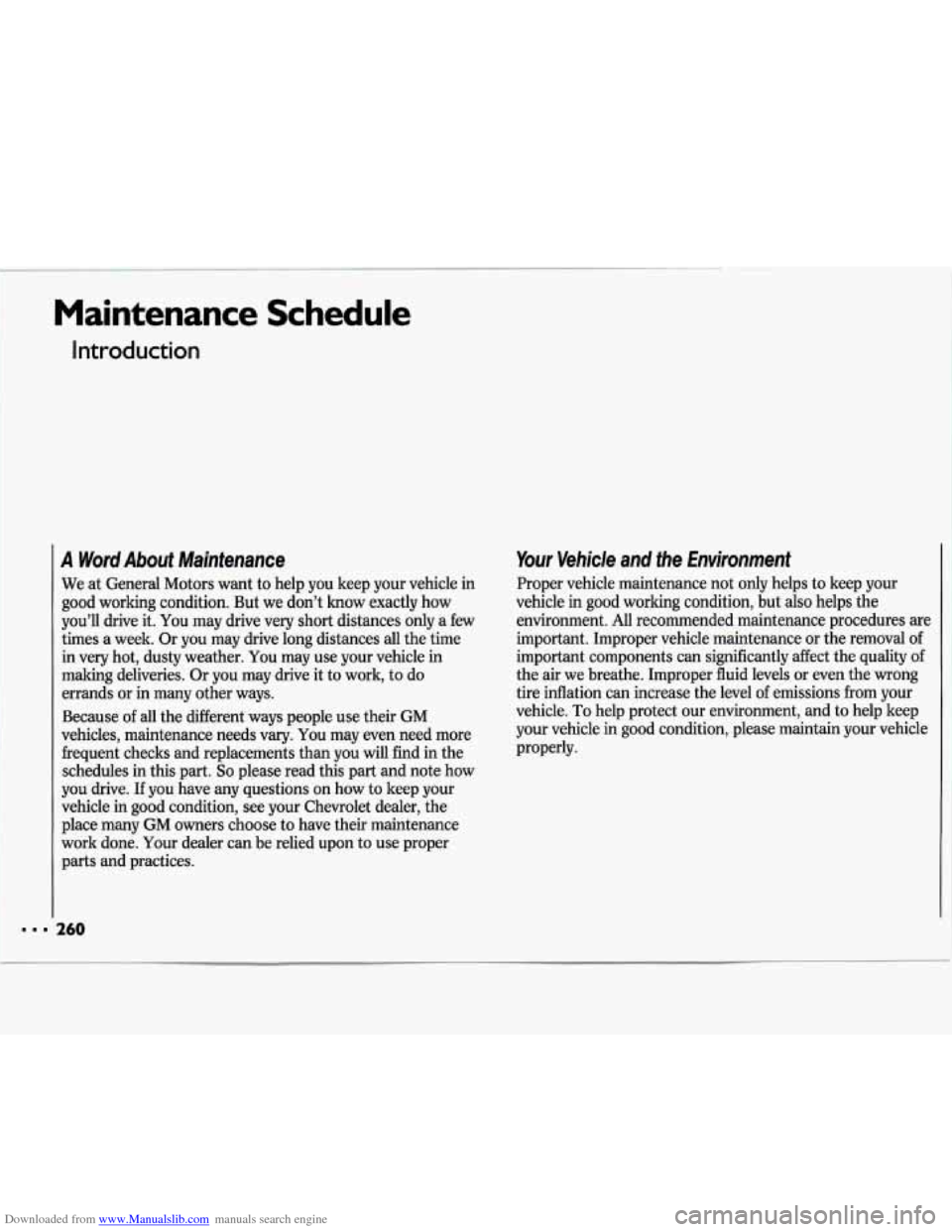
Downloaded from www.Manualslib.com manuals search engine Maintenance Schedule
Introduction
A Word About Maintenance
We at General Motors want to help you keep your vehicle in
good working condition. But we don’t know exactly how
you’ll drive it.
You may drive very short distances only a few
times a week. Or you may drive long distances
all the time
in very hot, dusty weather.
You may use your vehicle in
making deliveries. Or you may drive it to work, to do
errands or in many other ways.
Because
of all the different ways people use their GM
vehicles, maintenance needs vary.
You may even need more
frequent checks and replacements than you
will find in the
schedules in this part.
So please read this part and note how
you drive. If you have any questions on how to keep your
vehicle in good condition, see your Chevrolet dealer, the
place many GM owners choose to have their maintenance
work done. Your dealer can be relied upon
to use proper
parts and practices.
Your Vehicle and the Environment
Proper vehicle maintenance not only helps to keep your
vehicle in good working condition,
but also helps the
environment. All recommended maintenance procedures are
important. Improper vehicle maintenance or the removal of
important components can significantly affect the quality of
the air we breathe. Improper fluid levels or even the wrong
tire inflation can increase the level of emissions from your
vehicle.
To help protect our environment, and to help keep
your vehicle in good condition, please maintain your vehicle
properly.
Page 263 of 324
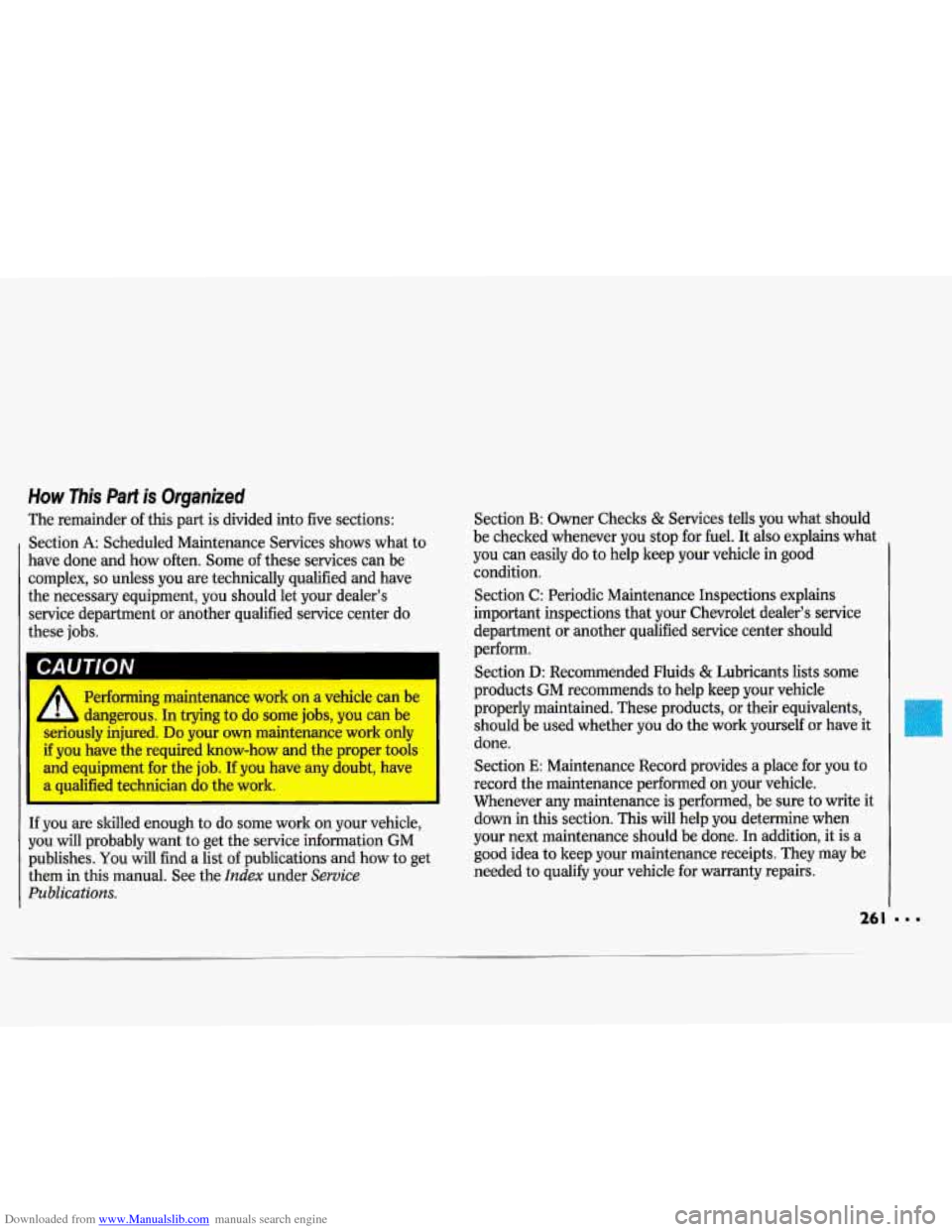
Downloaded from www.Manualslib.com manuals search engine How This Parf is Organized
The remainder of this part is divided into five sections:
Section
A: Scheduled Maintenance Services shows what to
have done and how often. Some of these services can be
complex,
so unless you are technically qualified and have
the necessary equipment, you should let your dealer’s
service department or another qualified service center do
these jobs.
CAUTION
Performing maintenance work on a vehicle can be
b dangerous. In trying to do some jobs, you can be
senously injured. Do your own maintenance work only
if you have the required
know-how and the proper tools
and equipment for the job. If you
have any doubt, have
a qualified technician do the work.
If you are skilled enough to do some work on your vehicle,
you
will probably want to get the service information GM
publishes.
You will find a list of publications and how to get
them in this manual. See the
Index under Service
Publications.
Section B: Owner Checks & Services tells you what should
be checked whenever you stop for fuel. It also explains what
you can easily do to help keep your vehicle in good
condition.
Section C: Periodic Maintenance Inspections explains
important inspections that your Chevrolet dealer’s service
department or another qualified service center should
perform.
Section
D: Recommended Fluids & Lubricants lists some
products
GM recommends to help keep your vehicle
properly maintained. These products, or their equivalents,
should be used whether you do the work yourself or have it
done.
Section
E: Maintenance Record provides a place for you to
record the maintenance performed on your vehicle.
Whenever any maintenance is performed, be sure to write it
down in this section. This
will help you determine when
your next maintenance should be done. In addition, it is a
good idea to keep your maintenance receipts. They may be
needed
to qualify your vehicle for warranty repairs.
26 I
Page 266 of 324
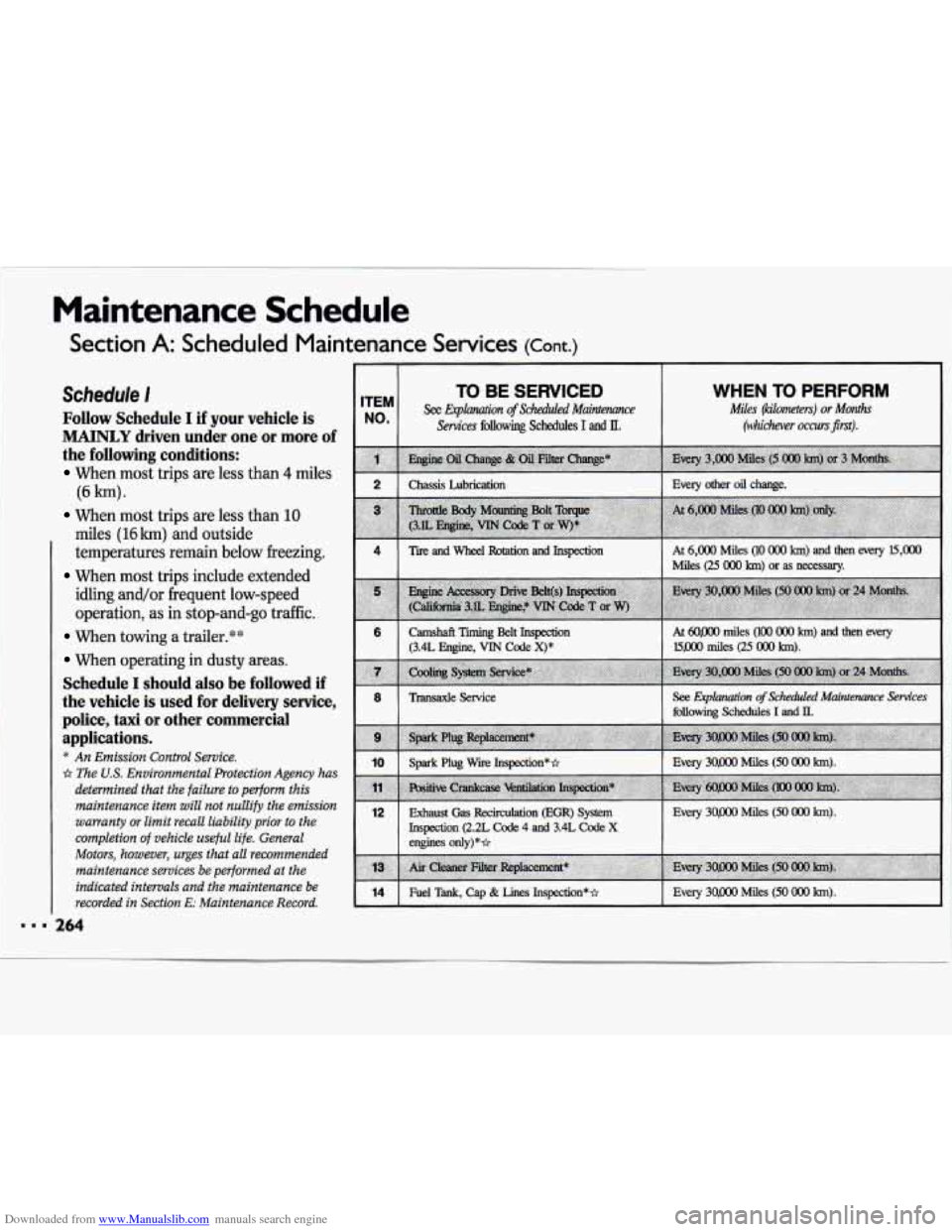
Downloaded from www.Manualslib.com manuals search engine ~~ Maintenance Schedule
Section A: Scheduled Maintenance Services (Cont.)
Schedule I
Follow Schedule I if your vehicle is
MAINLY driven under
one or more of
the following conditions:
When most trips are less than 4 miles
When most trips are less than 10
(6 km)
miles (16 km) and outside
temperatures remain below freezing.
When most trips include extended
idling and/or frequent low-speed
operation, as
in stop-and-go traffic.
When towing a trailer.**
When operating in dusty areas.
Schedule I should also be followed if
the vehicle is used for delivery service,
police,
taxi or other commercial
applications.
* An Emission Control Service.
Irr The U.S. Environmental Protection Agency has
determined that the failure to perform this
maintenance item will not nullify the emission
warranty
or limit recall liability prior to the
completion
of vehicle useful life. General
Motors,
however, urges that all recommended
maintenance services be performed at the
indicated intervals and the maintenance be
recorded in Section
E: Maintenance Record.
ITEM
NO.
TO BE SERVICED
See .?Zaplanation ofSch&d Mairueme
Services following Schedules I and I[.
WHEN TO PERFORM
Miles (kilometem) or Months
(whichever
occumjmt). I
2 Chassis Lubrication I
Ti and Wheel Rotation and Inspection At 6,000 Miles (lo OOO km) and then every l5,OOO
Miles (25 000 km) or as necessary. I
Camshaft Ti Belt Inspection
(3.4L Engine, VIN Code X)*
At 60,000 miles (lo0 OOO km) and then every
lspoo miles (25 ooo km). I
10 I ' Spark Plug Wire Inspeaion** I Every 30,000 Miles (50 000 km). I
12 Exhaust Gas Recirculation (EGR) System
Inspection (2.2L Code 4 and 3.4L Code X
engines only)**
Every 30,OW Miles (50 OOO km). I
14 I Fuel Tank, Cap & Lines Inspection** I Every 30,000 Miles (50 OOO km). I1 I I
Page 271 of 324

Downloaded from www.Manualslib.com manuals search engine ITEM
NO. SERVICE
6 Camshaft Timing Belt Inspection (3.4L Code X
engine only)*-Inspect for cracks, wear or oiliness.
Check tensioner for proper operation. See the
service manual.
(To purchase a service manual,
see the
Index under Service Publications.)
Replace parts as needed.
Cooling System Service*-Drain, flush and refill
the system with new or approved recycled coolant
conforming to
GM Specification 1825M. Keep
coolant at the proper mixture as specified. See the
Index under Coolant. This provides proper freeze
protection, corrosion inhibitor level and engine
operating temperature.
7
8
Inspect hoses and replace if they are cracked,
swollen or deteriorated. Tighten screw-type hose
clamps. Clean the outside of the radiator and air
conditioning condenser. Wash the pressure cap
and neck.
To help ensure proper operation, we recommend a
pressure test of both the cooling system and the
pressure cap.
Transaxle Service-For manual transaxles, fluid
doesn’t require changing.
For automatic transaxles, change both the fluid
and filter every 15,000 miles (25
000 km) if the
vehicle is mainly driven under one or more
of
these conditions:
ITEM
NO.
9
10
11
SERVICE
In heavy city traffic where the outside
temperature regularly reaches
90°F (32°C) or
higher.
In hilly or mountainous terrain.
When doing frequent trailer towing. (With some
models you shouldn’t ever tow a trailer. See the
Index under Towing a Trailer.)
Uses such as found in taxi, police car or delivery
service.
If you do not use your vehicle under any of these
conditions, change both the fluid and filter every
100,000 miles
(160 000 km).
Spark Plug Replacement*-Replace spark plugs
with the proper type. See the
Index under
Replacement Parts.
Spark Plug Wire Inspection*+Inspect for
burns, cracks
or other damage. Check the boot fit
at the coils and at the spark plugs. Replace wires
as needed.
Positive Crankcase Ventilation System
Inspection*-Inspect system for proper function.
Replace any
worn, plugged or collapsed hoses or
seals. Replace valve only if necessary.
269 .
Page 272 of 324
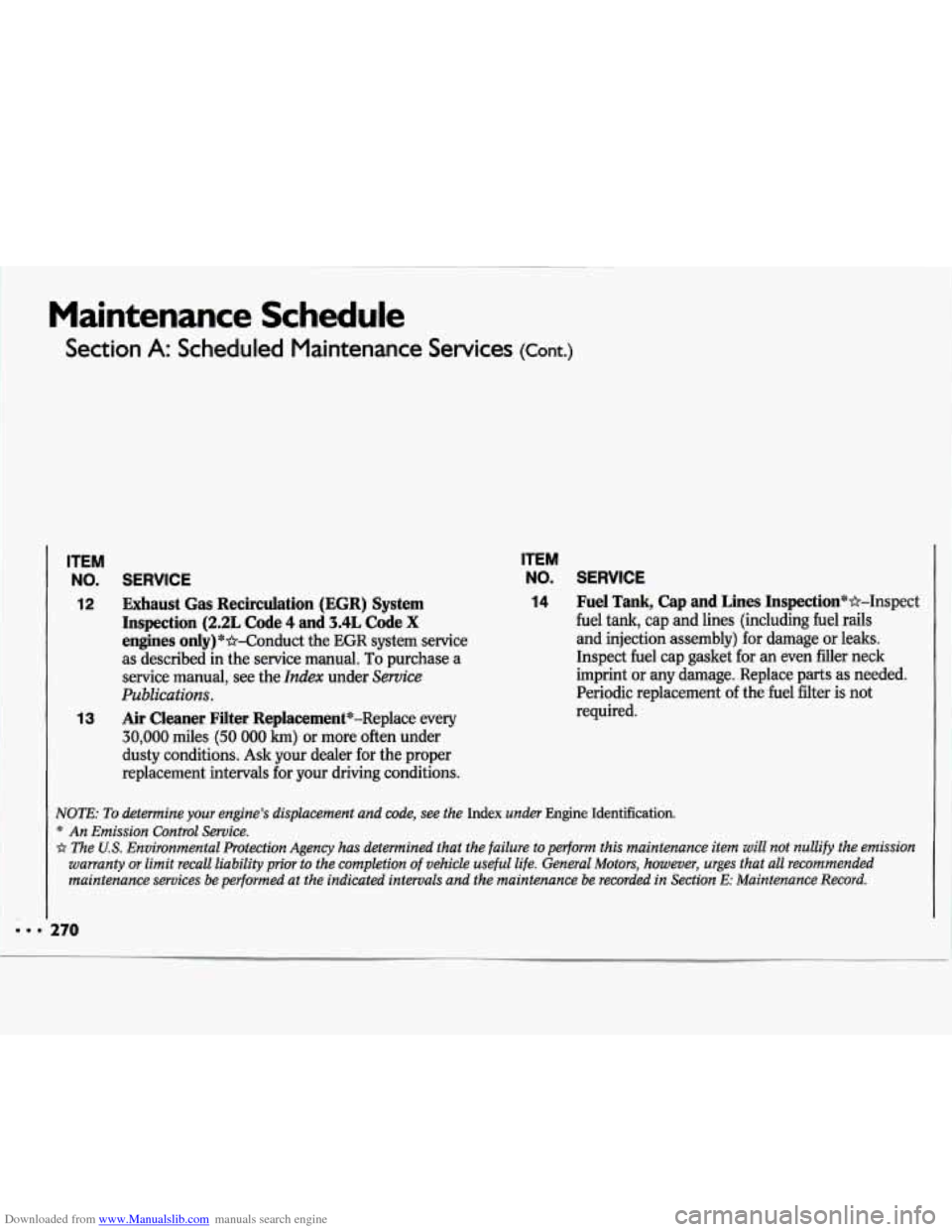
Downloaded from www.Manualslib.com manuals search engine Maintenance Schedule
Section A: Scheduled Maintenance Services (Cont.1
ITEM
NO.
12
13
SERVICE ITEM NO. SERVICE
Exhaust Gas Recirculation (EGR)
System
Inspection (2.2L Code
4 and 3.4L Code X
engines only)*-&
To purchase a
service manual, see the
Index under Service
Publications.
Air Cleaner Filter Replacement*-Replace every
30,000 miles (50 000 km) or more often under
dusty conditions.
Ask your dealer for the proper
replacement intervals
for your driving conditions.
14 Fuel Tank, Cap and Lines Inspection*+Inspect I
fuel tank, cap and lines (including fuel rails
and injection assembly) for damage
or leaks.
Inspect fuel cap gasket for an even filler neck
imprint or any damage. Replace parts as needed.
Periodic replacement of the fuel filter is not
required.
NOTE: To determine your engine’s displacement and code) see the Index under Engine Identification
* An Emission Control Service.
A The U.S. Environmental Protection Agency has determined that the failure \
to perform this maintenance item will not nullify the emission
warranty
or limit recall liability prior to the completion of vehicle useful life. General Motors, however, urges that all recommended
maintenance services be performed at the indicated intervals and the maintenance be recorded in Section E: Maintenance Record.